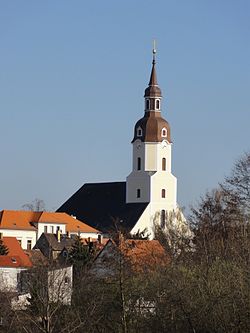Taucha
| Taucha | ||
|---|---|---|
 |
||
|
||
| Coordinates: 51°22′48″N 12°29′37″E / 51.38000°N 12.49361°ECoordinates: 51°22′48″N 12°29′37″E / 51.38000°N 12.49361°E | ||
| Country | Germany | |
| State | Saxony | |
| District | Nordsachsen | |
| Government | ||
| • Mayor | Holger Schirmbeck (SPD) | |
| Area | ||
| • Total | 33.70 km2 (13.01 sq mi) | |
| Elevation | 128 m (420 ft) | |
| Population (2015-12-31) | ||
| • Total | 15,128 | |
| • Density | 450/km2 (1,200/sq mi) | |
| Time zone | CET/CEST (UTC+1/+2) | |
| Postal codes | 04425 | |
| Dialling codes | 034298 | |
| Vehicle registration | TDO | |
| Website | www.taucha.de | |
Taucha is a town in the district of Nordsachsen, in the Free State of Saxony, Germany. It is situated on the river Parthe, 10 km northeast of Leipzig.
Taucha is part of the Leipzig Bay. The Parthe runs through the city, and its expansive floodplain surrounding the city is a protected nature area. The landscape outside of the floodplain was formed by ice age (Wolstonian Stage) terminal moraines. Remains of former volcanoes, which have been used as stone quarries, can still be found in the area.
Taucha consists of the city of Taucha itself and the districts Cradefeld, Dewitz, Graßdorf, Merkwitz, Plösitz, Pönitz, Seegeritz, and Sehlis.
The location was first mentioned by Bishop Thietmar of Merseburg in 974 as urbs Cothung. In 1170, the market town Tuch was awarded town privileges by the Archbishop of Magdeburg Wichmann von Seeburg. This planted the seeds of a rivalry with Leipzig, which belonged at the time to the Margravate of Meissen. As an apparent attempt to express the city's independence, Archbishop Albert von Magdeburg commissioned a castle and city wall in 1220.
In 1282 Dietrich von Landsberg, the Margrave of Meissen, sieged the city and razed the castle after capturing it. After Archbishop Otto von Hessen finally renounced ownership of the city in 1355, Taucha became a fief of the Margravate of Meissen. In 1569, the Leipzig council bought the city and manor in Taucha.
In 1621 a mint (facility) was established in the city. The mint produced so-called Kippermünzen, a coin currency used during the crisis of Kipper und Wipper.
...
Wikipedia



